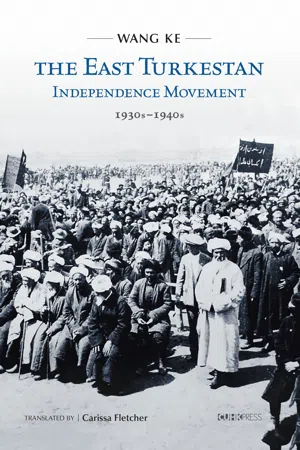
The East Turkestan Independence Movement
1930s to 1940s
- English
- PDF
- Available on iOS & Android
The East Turkestan Independence Movement
1930s to 1940s
About this book
Based on rare first-hand historical data, Wang Ke presents the analysis of the East Turkestan from the perspective of Islamic social structure, the origin and evolution of thoughts on national revolution, the power structure of the Republic, and international politics. The original Japanese edition of this book has been recognized as the most authoritative research work on the independence movement of East Turkestan. This revised, enriched English edition provides valuable references for the prominent issues of Xinjiang today.~~~~~~~"For those intrigued by the modern history of China's Xinjiang region, this detailed study of the 1940s invites the reader to explore a tempestuous decade marked by conflict and turmoil as Uyghurs, Kazakhs and other ethnic groups sought to form an independent state, the East Turkestan Republic. Understanding the complex involvement of powerful outside forces, a brutal world war, and an opportunity for groups that saw a chance at independence requires careful examination, and Professor Wang's book does an admirable job in doing so. His exceptionally well-written book offers numerous insights, many based on materials that range from diaries and documents to memoirs and personal interviews. Altogether, Wang's recently translated account strengthens our understanding of Xinjiang's mid-20th century conundrum."—Linda Benson, Professor Emerita, Oakland University"The history of efforts to build an independent East Turkestan in the 1930s and 1940s is complex and controversial. Wang Ke's detailed reading of 20th-century Chinese and Uyghur sources, complemented by Japanese secondary materials, informs a valuable account of the Sheng Shicai era in Xinjiang, the short-lived Eastern Turkestan movement of 1933–1934 and especially of the Eastern Turkestan Republic that governed northern Xinjiang from 1944 to 1949, a state whose influence is still felt today despite efforts to erase it from official narratives. This research, now available in English, is an important addition to the growing library of work on modern Xinjiang and Uyghur history."—James Millward, Professor, Georgetown University
Frequently asked questions
- Essential is ideal for learners and professionals who enjoy exploring a wide range of subjects. Access the Essential Library with 800,000+ trusted titles and best-sellers across business, personal growth, and the humanities. Includes unlimited reading time and Standard Read Aloud voice.
- Complete: Perfect for advanced learners and researchers needing full, unrestricted access. Unlock 1.4M+ books across hundreds of subjects, including academic and specialized titles. The Complete Plan also includes advanced features like Premium Read Aloud and Research Assistant.
Please note we cannot support devices running on iOS 13 and Android 7 or earlier. Learn more about using the app.
Information
Table of contents
- Half Title
- Full Title
- Copyright
- Dedication
- Contents
- List of Figures and Tables
- Frontispiece
- Introduction
- 1. The “Ummah” and “China”: The Qing Dynasty’s Rule over Uyghur Societyin Xinjiang
- 2. Origins of the East TurkestanIndependence Movement: Social Context and Shape of the Movement
- 3. The Anti-Japanese,Pro-Soviet Agenda: Surface and Substance: Sheng Shicai’s Political Agenda and Ethnic Problemsin Xinjiang
- 4. The Dual Power Structure and Ethnic Problems: The Political Agenda and Ethnic Policies underSheng Shicai’s Regime
- 5. Soviet-Backed “Jihad” by the Turkic-Islamic Peoplesof China: The Rise of the Second Independence Movement andthe Ghulja Uprising
- 6. Authority and Power: Political Structure of the East Turkestan Republicin Wartime
- 7. The Meeting Point ofNationalism and Communism: Soviet Backdrop to the Expansion of the East Turkestan Republic
- 8. International Politics andthe Tragedy of the Republic: Behind the Scenes of the Xinjiang Peace Talks
- 9. “National Independence”or “National Liberation”: The Fall of the East Turkestan Republic
- 10. Ideals Versus Reality: A Detailed Analysis of the SecondEast Turkestan Independence Movement
- Postscript
- Timeline of Important Events
- Notes